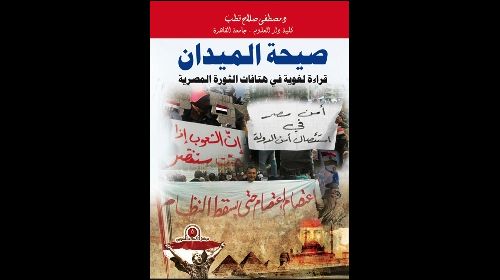The Arena’s Outcry
by Hamdy El-Gazzar / January 27, 2014 / No comments
A new book studies the lexicon of the Egyptian Revolution.
In Tahrir Square and across many other arenas during the Revolution, Egyptians shouted and wrote:

- “From Egypt” attempts to draw a cultural map of Egypt and the Arab world by profiling the artistic, literary, and political issues that affect the region via on-the-ground coverage of current events, publications, and the fight for freedom of expression.

- Hamdy El-Gazzar is an Egyptian writer and one of the 39 young Arab writers included in the Beirut 39 Project. His first novel, Sihr Aswad (Dar Merit, 2005) won the prestigious Sawaris Award, and was subsequently translated by Humphrey Davies (Black Magic, AUC Press, 2007). His second novel, Ladhdhat Sirriyya (Secret Pleasures) was published by Dar al-Dar in 2008. He is currently working on a third novel.
“Go away go away
Take off, Mubarak, and wash your disgrace
If you’re a dictator in stubbornness, we’re professors in patience
Go away enemy of the farmer
Be proud, you’re an Egyptian
Fill out the leave form
Live freedom, social justice
The people want to topple the regime
Sit-in, sit-in until the regime falls
Give me my freedom, release my hands
Burying this regime is respect
I’m in Tahrir until freedom
Long live Egypt, long live National Unity
Our revolution is the people’s, against gangs of thieves
Sheikh and priest let the president leave
Human dignity, justice, and freedom
People demand the removal of the regime
With the names of the artists, your reign is junk
Glory! Mubarak’s people took him off.”
Slogans and shouts like this one were created and chanted over the course of the January 25th Revolution. Some of them are now famous among Egyptians, while others have been memorialized in academic writing, such as the new book, The Arena’s Shout: A Linguistic Reading of Egyptian Revolutionary Shouts by Dr. Mostafa Salah Kotb, the head of Linguistics department in Dar El-Ulum, University of Cairo.
According to Dr. Kotb, 650 different slogans were chanted during the January 25th Revolution. Of these, 354 (almost 54%) were classified as using formal language, and 290 (almost 45%) were classified as being comprised of informal language. The remaining one percent consisted of six slogans that were translated into foreign languages.
In his analysis, Dr. Kotb explains that the slogans and shouts are first and foremost a linguistic art. Accordingly, they must be parsed linguistically to determine their nature and characteristics. He then analyzes them according to the known linguistic levels—phonological, morphological, compositional, lexical, and semantic—but doesn’t lose focus of the slogans’ stylistic characteristics, which are based in the linguistic choices the composers used to express themselves.
These slogans express the psychological state that the composers were experiencing in certain situations and events, and list the demands they delivered from the streets to the country’s highest authority. As such, the linguistic choices of each slogan are connected to the context of the situation in which they were created.
The book also presents a linguistic and a lexical analysis of the January 25th Revolution, along with Dr. Kotb’s reflections on the Revolution’s words, slogans, semantics, and hints. In this analysis he ultimately ends up with an alphabetical lexicon of slogans and shouts from the Revolution.
This book, which was issued in 2013 by the Arab Media Center, is one of the first serious academic studies about the shouts and slogans of the Egyptian Revolution. It will have a prominent place, not only in the library of this glorious revolution, but also in the canon of contemporary linguistic studies.





